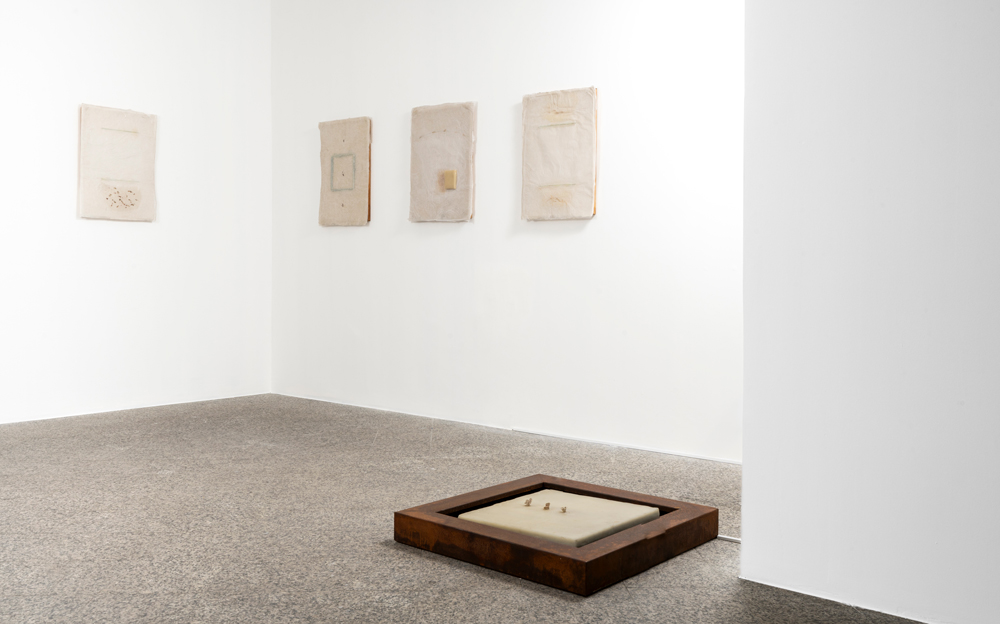curated by Chiara Gatti and Elisabetta Masala
with a critical text by Davide Ferri
In the beginning, there was light.
But also water and fire, wax and lead, all shaped by time and the elements. In the work of the Neapolitan artist (born in 1953), the ancient power of these elements engages in dialogue with classical iconographies, exploring themes of the sacred and the unseen
For the MAN in Nuoro, Gregorio Botta has created a new project that, drawing on his research into balance and silence, distils abstract forms within space, creating an interplay of reflections and transparencies in the material, pure geometries, raindrops, streams of water and staves punctuated by minimal shapes.
The exhibition title, Silence is so accurate, inspired by a quote from Mark Rothko, embarks on a journey where the precision of the drawing defines distant horizons and traces the passage of time through the circuits and mechanisms of small, solitary machines, as Duchamp might have described them. These absurd machines, lacking specific function, are poetic in their orchestration of movement in a vacuum, producing sounds, vapours or free-flowing writing in space.
When iron and glass, alabaster and dried flowers come together, they create intimate landscapes, enclosed architectures, and references to everyday iconography – objects, symbols and allegories of a life stitched onto waxed paper, which is consumed, worn, and transfigured in anticipation. Epiphanies and disappearances, secrets and subtle revelations, all reflect Botta’s commitment to “an art of removal, of little, of less, with the hope of reaching an art of nothing. An art that disappears, leaving only, like a vibration, like a hidden motor, the very action for which it was created.”
The imprint serves as a trace of legacy in the Pompei series, while the weight of the smoke represents the enduring presence of matter in the work that lends the exhibition its title.
Melted wax, shaped into archetypal forms, evokes Morandi-like patterns on a crystal plane that stretches infinitely in the Orizzonti cycle, where the timeless theme of the threshold carries with it the rich literary tradition exploring the boundary between the visible and the invisible, between the contingent and the immaterial.
Biography
Gregorio Botta
Gregorio Botta was born in Naples on 18 April 1953. In 1980 he enrolled at the Accademia di Belle Arti in Rome, where he attended the courses taught by Toti Scialoja, graduating in 1984.
After his debut, during which he participated in several exhibitions at the Galleria Rondanini and had his first solo exhibitions at the Galleria Il Segno, both in Rome, he attracted the attention of critics on the occasion of important exhibitions, including Trasparenze dell’arte italiana sulla via della seta (Transparencies of Italian Art on the Silk Road) curated by Achille Bonito Oliva, held in Beijing in 1993, the XII Quadriennale and the Biennale dei Parchi at the Galleria Nazionale d’Arte Moderna in Rome, held in 1996 and 1998 respectively, as well as the solo exhibition, also in 1998, presented by Ludovico Pratesi at the Italian Cultural Institute in Cologne. In 2006 he presented a selection of works at the Magazzini del Sale in Siena in which particular elements of his language reappear in a unique interplay of contrasts: the lightness and transparency of glass, the opacity and hardness of iron. The introduction of movement is unprecedented, animating installations such as La Porta di Pietro, inspired by Piero della Francesca’s Madonna del Parto.
His solo exhibitions have included: Fondazione VOLUME!, Rome (2024, 2009); Galleria Peola Simondi, Turin (2023, 2020); Galleria Studio G7, Bologna (2021), Galleria Nazionale d’arte moderna, Rome (2020); Cripta Borromini in San Giovanni dei Fiorentini, Rome (2019); Francesca Antonini Arte Contemporanea, Rome (2017); MAC — Museum of Contemporary Art, Santiago de Chile (2016); MAC — Museum of Contemporary Art, Lima, Peru (2016); Centro d’arte contemporanea Pescheria, Pesaro (2016); Milan Triennale (2015); Forte di Bard, Aosta (2014); Palazzo Te, Mantua (2014), MACRO, Rome (2012); Magazzini del Sale, Siena (2006); Certosa di Padula, Salerno (2005); Vanvitelli underground station, Naples (2005); Galleria Lo Scudo, Verona (2001); Italian Cultural Institute, Cologne (1998). He designed the sets for three shows by Sergio Rubini: Delitto e Castigo, Dracula and Il caso Jekyll. A writer and essayist, his work has been published by Einaudi (2020) Pollock e Rothko, il gesto e il respiro and by Laterza (2022) Paul Klee, genio e regolatezza.

